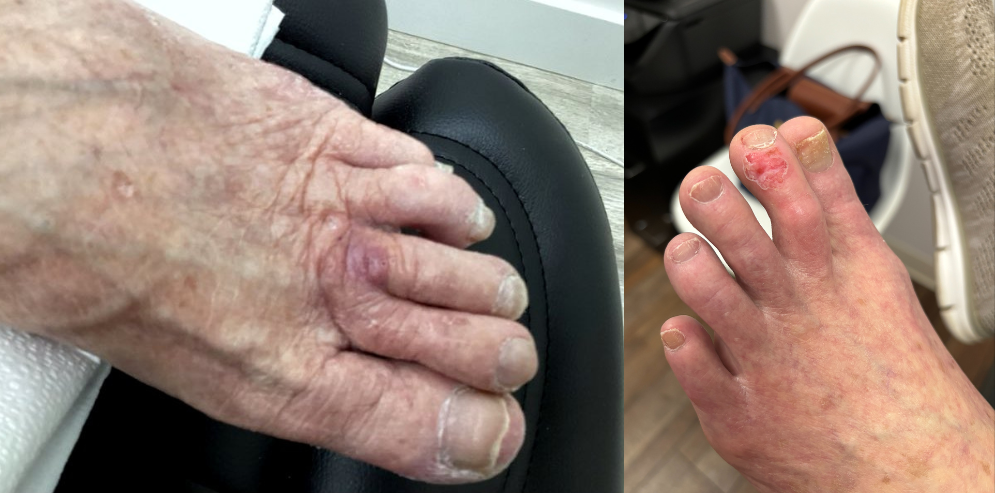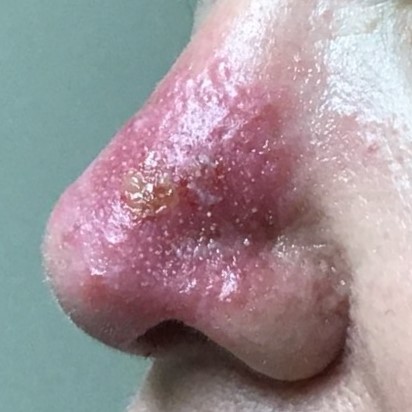
When it comes to skin cancer awareness, many people focus on the most exposed areas of their bodies, such as the face, arms, and legs. However, it’s crucial not to overlook the hidden danger that can lurk in unexpected places — your toes. No one wants to wake up one day and question, “Do I have skin cancer on my toe?” The truth is that skin cancer can develop anywhere on the body, including the often-neglected spaces between our toes. In this blog, we will explore how to identify skin cancer on the toes and discuss preventive measures to keep your feet healthy.
What Does Skin Cancer on the Toe Look Like?
Do you have skin cancer on your toes? There are several ways to determine whether you have skin cancer on your toes or not, including understanding the ABCDEs of skin cancer.
- Change in Color: Keep a close eye on any changes in color on your toes. Skin cancer may present itself as dark, irregular pigmentation or changes in the existing color of the skin. Pay attention to any spots that stand out or look different from the surrounding skin.
- Unusual Moles or Lesions: Check for any moles or lesions that appear suddenly, grow rapidly, or have irregular borders. Skin cancers often manifest as new growths or changes in existing moles. If you notice anything unusual, consult a dermatologist promptly.
- Persistent Itching or Pain: Skin cancer may cause persistent itching, tenderness, or pain. If you experience discomfort that doesn’t subside or intensifies, it’s essential to seek professional medical advice.
- Bleeding or Oozing: Any wound or sore that bleeds, oozes, or doesn’t heal should raise concerns. Skin cancers can ulcerate, leading to these symptoms. If you observe such signs, consult a healthcare professional promptly.
ABCDEs of Skin Cancer Explained
Curious about skin cancer’s ABCDEs? Each letter represents a common visual sign linked to one or more forms of the disease:
- Asymmetry
- Border
- Color
- Diameter
- Evolving
If any unexplained growth on your body shows even one of these signs, it’s crucial to consult with a professional promptly. You can find out more about the ABCDEs of skin cancer here.
Types and Signs of Foot and Toe Cancers
What does skin cancer on the toe look like? Cancer can be a formidable adversary, and while many are aware of its prevalence in various parts of the body, foot cancer often goes under the radar. Below are signs of the three most common types of skin cancer that can occur on your feet and skin cancer on the toes.
- Typically found on sun-exposed skin.
- Less common on the feet due to limited sun exposure.
- Relatively non-aggressive.
- Causes local damage with rare spreading beyond the skin.
- Appears as pearly white bumps or patches.
- May ooze or crust.
- Resembles non-cancerous skin tumors or ulcers on the lower legs and feet.
- Most prevalent foot skin cancer.
- Usually confined to the skin in early stages.
- Some advanced cases can become aggressive and spread.
- Initial signs include small, scaly bumps or inflamed plaques.
- May be itchy.
- Occasionally starts as a hard callus-like lesion.
- Resembles other foot conditions like plantar warts or ulcers.
- Among the deadliest skin cancers.
- Can occur on the feet, including beneath toenails.
- Early detection crucial for survival.
- Can grow and spread through lymphatics and blood vessels.
- Appearance varies.
- Starts as small brown-black spots or bumps.
- Approximately one-third lacks brown pigment, appearing pink or red.
- Can be mistaken for moles, warts, or bruises.
- Emphasizes the importance of close inspection for asymmetry, irregular borders, color changes, or a diameter exceeding 6 mm.
Preventive Measures:
- Regular Self-Examinations: Make self-examinations of your toes a routine. Take note of any changes in color, shape, or texture and seek professional advice if you notice anything unusual.
- Sun Protection: Protect your feet from harmful UV rays by applying sunscreen. When spending time in the sun, ensure that your feet are adequately covered or use sunscreen with a high SPF on exposed areas.
- Footwear Choices: Opt for footwear that covers your feet and toes, especially during prolonged sun exposure. This provides an additional layer of protection against UV radiation.
- Stay Hydrated: Keep your skin healthy by staying hydrated. Proper hydration contributes to overall skin health and reduces the risk of skin-related issues.
- Regular Check-ups: Include a comprehensive foot examination in your regular health check-ups. A healthcare professional can detect potential issues early on and provide timely intervention.
Skin cancer on the toes may not be as commonly discussed as other forms of skin cancer, but its impact can be just as severe. By staying vigilant, practicing regular self-examinations, and taking preventive measures, you can safeguard your feet and overall well-being. Remember, early detection is key, so don’t hesitate to consult a dermatologist if you notice any suspicious changes on your toes. Your proactive approach today can lead to a healthier tomorrow.
Learn About Treatment for Skin Cancer on Your Toes With GentleCure™
If you’ve received a skin cancer on foot or toe diagnosis, you do have treatment options. Image Guided Superficial Radiotherapy is a surgery-free treatment for common skin cancer. Want to learn more? Our skin cancer information specialists can answer your questions at 855-936-4411. Discover how it works today.








